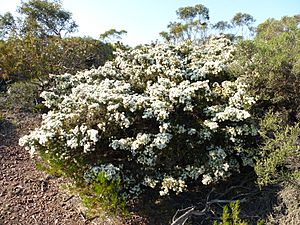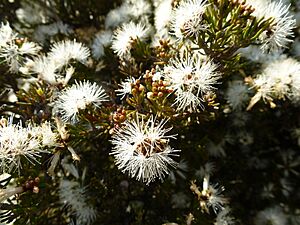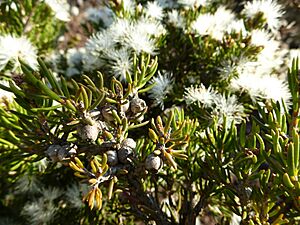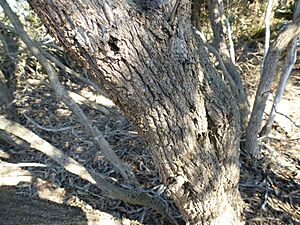Melaleuca teuthidoides facts for kids
Quick facts for kids Melaleuca teuthidoides |
|
|---|---|
 |
|
| M. teuthioides growing 10 km east of Ravensthorpe | |
| Scientific classification | |
| Genus: |
Melaleuca
|
| Species: |
teuthidoides
|
Melaleuca teuthidoides is a cool plant that belongs to the myrtle family, called Myrtaceae. You can only find it growing naturally in the southern part of Western Australia. It's a type of bush, or shrub, that has rough bark and pretty white flowers. These flowers grow in clusters at the end of its branches during spring and early summer.
Contents
What Does This Plant Look Like?
Melaleuca teuthidoides is a shrub that can grow up to about 3 m (10 ft) tall. It has rough, grey bark that looks like it has cracks in it. Its leaves are placed one after another along the stem. They are quite small, about 2.5–8 mm (0.1–0.3 in) long and 0.9–1.3 mm (0.04–0.05 in) wide. They are shaped like a very narrow oval and are half-round if you cut them in half.
The flowers of this plant are white and grow in groups or spikes. You'll find them at the very ends of the branches. What's cool is that the branches keep growing even after the flowers have bloomed! Sometimes, you might also see flowers growing where the leaves meet the stem. Each group of flowers has about 3 to 9 individual flowers and can be up to 20 mm (0.8 in) wide.
Flower Details
Inside each flower, there are five groups of stamens, which are the parts that make pollen. Each group has about 12 to 16 stamens. The plant usually flowers from September to January. After the flowers, the plant grows woody fruits called capsules. These capsules are about 4–5.5 mm (0.16–0.22 in) long.
How Did It Get Its Name?
The plant Melaleuca teuthidoides was officially named in 1988 by two scientists, Bryan Barlow and Kirsten Cowley. They published their findings in a science journal called Australian Systematic Botany.
Meaning of the Name
The second part of its name, teuthidoides, comes from old Greek words. Teuthis means "squid," and eîdos means "likeness" or "looking like." So, the name means "squid-like." This is because parts of its flowers, called sepals, reminded the scientists of a squid's arms!
Where Does This Plant Grow?
This special melaleuca plant is found in a few areas in Western Australia. You can see it in places like Marvel Loch, Ravensthorpe, and Balladonia. These areas are part of different natural regions, including the Avon Wheatbelt, Coolgardie, Esperance Plains, and Mallee.
The plants like to grow in sandy or clay soils. You'll often find them in low areas that fill up with water after it rains.
Is This Plant Safe?
Good news! The Melaleuca teuthidoides is currently listed as "not threatened" by the Government of Western Australia's Department of Parks and Wildlife. This means it's not in danger of disappearing right now.
Images for kids
-
Habit 10 km (6.2 mi) east of Ravensthorpe





